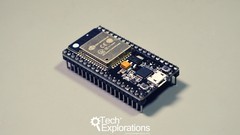Tech Explorations ESP32 For Arduino Makers (Udemy.com)
Use this powerful microcontroller to turbo-boost your Arduino projects
Created by: Dr. Peter Dalmaris
Produced in 2022
 What you will learn
What you will learn
- Learn about the ESP32 and what makes it an excellent choice for Arduino Makers.
- Learn about the differences and similarities between the ESP32 and the Arduino.
- Learn about the variants of the ESP32 module.
- Learn about the features ESP32 development kit.
- Learn how to use the ESP32 in place of the Arduino to do things such as controlling LEDs, reading button and potentiometer states, drive displays and motors, read data from digital and analog sensors (including internal sensors).
- Learn how to use the ESP32 more advanced capabilities, like its flash memory (as a file system), the digital to analog and analog to digital converters.
- In the end, become confident in using the ESP32 in your projects.
- Learn how to use the ESP32 to enable your project to communicate with the Internet.
- Learn how to use the ESP32 to enable your project to communicate with Bluetooth devices (classic and BLE).
 Quality Score
Quality Score
Overall Score : 96 / 100
 Live Chat with CourseDuck's Co-Founder for Help
Live Chat with CourseDuck's Co-Founder for Help
 Course Description
Course Description
It integrates Wifi and Bluetooth, many GPIOs, analog input and output capabilities, many device interconnection protocols, a fast dual-core processor.
All that, at a low price.
And best of all: you can use your existing Arduino knowledge and skill to turbo-charge your projects.
Especially if you have already learned how to use the Arduino Uno in your projects, it is likely that you have hit a hardware limitation.
Perhaps your projects needed more memory, more speed, or more pins.
With the ESP32, you can get a lot more capacity to build more interesting projects, almost for free.
However, the ESP32 is not a plug-in replacement for the Arduino.
While it shares much of the Arduino's programming and GPIO interface, you still need to learn the basics before you can deploy it.
This is the purpose of this course.
In this course you will learn:
- What is the ESP32.
- What are the various modules with that name, and how these modules are available to us in the form of development kits.
- What are the differences and similarities between the ESP32 and the Arduino.
- How can we use what we know from the Arduino to make things based on the ESP32.
- How can we use the ESP32 GPIOs to work with simple components like LEDs and buttons, but also to drive peripherals like displays, sensors (including the integrated ones) and motors.
- How can we set up the familiar Arduino IDE so that we can write programs for the ESP32.
- How to store data in non-volatile memory.
- How to communicate with near field devices and the Internet.
Larger projects will also show you how to create simple Internet of Things and Bluetooth applications, to name a few.
If you are ready to learn more, please be sure to watch the lectures in this introductory section to find our more.Who this course is for:
- People who are already making things with the Arduino and are looking for a more powerful microcontroller.
- People who want to use the ESP32 but are not sure how to start.
 Instructor Details
Instructor Details

- 4.8 Rating
 36 Reviews
36 Reviews
Dr. Peter Dalmaris
Peter Dalmaris is an educator, electrical engineer, electronics hobbyist, and Maker. Creator of online video courses on DIY electronics and author of three technical books, and has recently released his book Maker Education Revolution.
As a Chief Tech Explorer since 2013 at Tech Explorations, the company he founded in Sydney, Australia, Peter's mission is to explore technology and help educate the world.
Tech Explorations offers educational courses and Bootcamps for electronics hobbyists, STEM students and STEM teachers.
A life-long learner, Peter's core skill is in explaining difficult concepts through video and text. With over 15 years of tertiary teaching experience, Peter has developed a simple yet comprehensive style in teaching that students from all around the world appreciate.
His passion for technology and in particular for the world of DIY open source hardware has been a dominant driver that has guided his personal development and his work through Tech Explorations.
Peter's current online courses have helped over 60,000 people from around the world to be better Makers.
For more information on Peter's work, please go to his web site.







